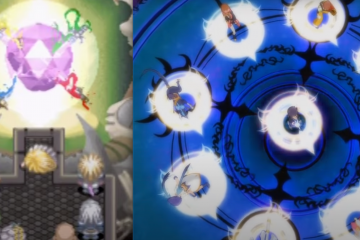Have you ever fancied a fictional character? Take a moment to mull it over in your mind, being totally honest with yourself.
If you answered “yes,” then congratulations! You are a normal human being with the capacity for empathy.
If you answered “no,” then you might just not be the best at being completely honest with yourself!
It is a well known and psychologically-backed fact that we have the capability—and, indeed, a strong tendency—to get attracted to the fictional characters that we watch, read about, and control in-game. Now, ask yourself: how incredible it would be to inhabit the same fictional universe as your fantasy crush and actually interact with them in a meaningful way? Wouldn’t that be awesome?
Well, as you probably guessed from the title of this article, I am here to show you just how wonderful relationships in video games can be. More specifically, I will show you that relationships with NPCs in video games create fantastical, interactive, interpersonal connections, not only in terms of engagement through the player’s role in the development of these emotional connections, but also in terms of the fantastical nature of these characters, with which players can experience kinds of connections that are impossible in the real world.
The Path to Empathy
To start off, I’d like to explain exactly why we all feel attraction to fictional characters in the first place. In truth, a lot of the feelings evoked by these interactions mirror those arising from real-life human communication and interactions. The key ingredient to this pattern of fictional romance is, as you might have guessed, empathy.[1] From a biological standpoint, empathy lives in a tiny region of the brain called the right supramarginal gyrus; in real life, this translates into the ability to figure out how someone else is feeling, often by using one’s own experiences as an emotional yardstick of sorts.[2] Humans have incredible empathic capabilities, as this is what allows us to understand those around us and forge even stronger social connections with one another.
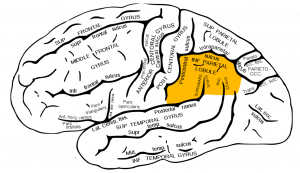
The area of the brain highlighted in yellow contains the supramarginal gyrus, where our empathy response is located.
Combined with the fact that fictional experiences involving sights, sounds, or smells are able to evoke neurological responses similar to real-world stimuli, we are very likely to empathize with fictional humans, or even with other races of fictional characters. Even if the stories we read and movies we watch are completely make-believe, suspension of disbelief further helps us become immersed in tales far beyond our wildest imagination. Our ability to empathize extends across to these fictional universes and their characters, which, when combined with the production of realistic feelings and sensations, alongside a healthy dose of imagination, results in the development of feelings of friendship—and perhaps even love—towards those characters.
Breaking Stereotypes
Just before starting my analysis, I’d like to get one more thing out of the way. We all know the stereotype of the shut-in male NEET (“Not in Education, Employment, or Training”): anti-social and alone, wasting his hours away playing video games in his room, trying to salvage what little connection he has to the rest of humanity through interaction with fictional characters that will never quite be real. This stereotype has become even more pronounced in developed countries, where people are surrounded by more technology than ever before and hence have more opportunities to isolate themselves from the world around them.
That is the stereotype.
However, I am not here to talk about the stereotype. Now that we’ve established that we frequently become attracted to fictional beings, I would like to show how video games use this attraction as a basis upon which to layer interactive game mechanics and fantasy universes to create relationship possibilities that extend beyond those of the real world.
Rune Factory 4: Essential Background
To convince you of the unique potential that video-game relationships hold, I will be analyzing Rune Factory 4 (which I will abbreviate to RF4 from now on), a simulation/role-playing game developed by Neverland Co. and published by Marvelous AQL for the Nintendo 3DS.[3] It is part of a larger series of Rune Factory titles that have been released over the years, but I chose this one since it is the most up-to-date and expansive, not to mention my favorite title in the entire series. RF4 combines the best attributes of a game taking place in a fantasy setting with a high degree of interactivity with its NPCs, resulting in one of the most profound and entertaining relationship-based games on the market.
The story begins with the player’s avatar (called ‘Lest’ if they choose a male avatar and ‘Frey’ if they choose a female one—I will use the name ‘Lest’ since I chose him at the start of the game) traveling by airship to a town called Selphia, where they are supposed to deliver a gift to its ‘god’. However, after the airship is invaded by rogue soldiers, Lest is hit in the head and then thrown out of the airship into the town, at which point amnesia immediately begins to set in. After being mistaken for a member of the royal family due to his memory loss, Lest is promptly entrusted with the duties of a town mayor and member of royalty who is supposed to run all aspects of Selphian urban life, from planning festivals to keeping the town safe from harm. Aside from attracting tourists to Selphia and helping to run the town, the player also helps Lest fight his way through nearby dungeons in which fearsome monsters have started to appear. Yet upon the realization that certain particularly powerful monsters are able to turn into humans upon their defeat, a greater plot is revealed, involving supernatural entities and a villain trying to take over the world.[4]
The rest of the story’s details are not so important for this article; the above is enough to give the basic context of RF4’s fantasy setting. The key aspect of the game’s plotline, for the purposes of this article, is the character development of each and every villager in Selphia.
Some of these characters are eligible bachelors or bachelorettes, whom the player can choose to marry depending on whether they are playing as Frey or Lest respectively.[5] In total, there are six bachelorettes and six bachelors, shown in the pictures below:
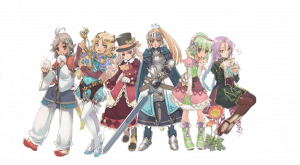
The bachelorettes. From left to right: Xiao Pai, Margaret, Dolce, Forte, Amber, and Clorica.
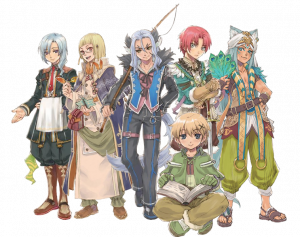
The bachelors. From left to right: Vishnal, Arthur, Dylas, Kiel (blond hair), Doug (red hair), Leon.
The process to marry one of the game’s NPCs involves dating them through a series of in-game events and then proposing to them, after which it is possible to live with them in a little Selphian house and eventually have a child. And it is this selfsame process of marriage in RF4 that is such a striking illustration of just how effectively interactive game design can enrich our relationships with fictional characters.
I Choose You! Or Maybe Not…
The very process of courting and then marrying an NPC in RF4 involves numerous choices that the player must make to ultimately succeed in winning the character’s favor.[6] To marry an NPC, the player must first raise their LP (Love Points) by going on dates with them or doing other game-specific activities such as questing, fishing, or even farming. The player may choose what these activities are, and some will be more effective in increasing certain NPCs’ LP. Besides going on a minimum of three dates with that character and having their LP at 10 or more, the player must also have triggered at least specific two events before getting down on one knee:
- at least one sub-event in which the player gets to know more about their favorite character
- a separate marriage event in which the player has their avatar propose
Like all events in the game, these trigger randomly, which leads to a much more natural pacing in the process of courting a NPC. Most importantly, though, these events require the player’s active participation in deciding whether to continue pursuing the NPC of their choice.
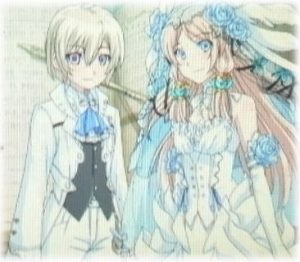
Wedding art from RF4.
Not only must the player wait for both a marriage sub-event and main event within the game’s RNG (Random Number Generator) event cycle, but, to add to this tall order, they must also have a double bed in their house—and an engagement ring, if they have a male avatar. In all, the dating and marriage system in RF4 is no cakewalk, requiring the player to make a sizable time commitment to complete all of the tasks and events needed to successfully court an NPC, and good luck on the side of the game’s RNG to have all of those events occur when the player wants them to.
It is not possible to fail at a marriage proposal within the game, and marriage is not a necessary task to perform to see the game’s main story to its end, making it a completely optional aspect of the game. However, the fact that marriage in this game is a choice is exactly what makes it so intriguing, as it gives the player freedom to choose exactly the outcome they want—be it living a single life, or marrying an NPC of their choice. Not marrying an NPC within the game could lead to an equally as interesting experience, as the player might find out that they do not fancy any characters in particular and thus decide to abstain from forming deeper relationships, similar to real life.
Even in the simple sense of choosing various dialogue options in conversations with various NPCs and taking them on quests and adventures of one’s choosing, it is clear that the interactive nature of video games allows them to transcend other popular media’s depictions of fictional relationships, such as those found in novels, films, or fan-made fiction online. Video game relationships are immersive compared to other traditional media forms, as they enable their players to get involved with the gameplay and narrative and make choices that then influence the outcomes of certain events. And when I say “immersive,” I am not just referring to an ambiguous buzzword floating around the gaming community. In the case of this article, I am using immersive to describe a game like RF4 that can emulate our experience in the real world by giving us the ability to develop and impact relationships between ourselves and the game’s characters, much like we do with real people in real life.
Another aspect of interactivity that contributes so much to the complexity of video-game relationships is replayability. Players can theoretically play RF4 over and over again, ad infinitum, making different decisions each time and dating different characters in different ways. This means you can explore multiple different relationships in multiple different contexts—something akin to what fans do by creating new stories based on their favorite character—just wrapped up in the succinct, coherent package of a single video game. When playing a video game, you can truly answer all the what-if questions simply by replaying the game and making different choices. In this way, the dynamic relationships of RF4 really do seem quite remarkable!
Is Video Game Interactivity the Best Form of Interactivity?
“But wait!” I hear you cry: “surely there are other forms of interactive entertainment that involve relationships, which could feasibly produce a similar effect on their participants?”
Well, I’m glad you asked! It is indeed true that there are other interactive activities involving relationships to some extent; however, none does so in the same way that video games do. Granted, choose-your-own-adventure novels or LARPing (Live-Action Role-Playing) could also be categorized as “interactive play.” However, neither is able to leverage the kind of complex relationship between player and avatar that exists in video games.
As you might have already gathered from my wording throughout this article, it is sometimes hard to distinguish between the player’s avatar and the actual player in a video game’s story. This is something unique to video games, where you are both simultaneously controlling a character and also embodying that character. As a result, there are multiple ways in which you can identify with your avatar.
On the one hand, you could be the type of player who likes to see themselves as their avatar, experiencing an avatar-NPC relationship as if it were taking place in your real life, and trying to experience similar things through an empathic and sensory response to the game. On the other hand, you could be the type of player who stays dissociated from their avatar’s identity, making choices based on what is good for your avatar, rather than letting your personal desires guide your in-game choices. This constitutes a much more paternalistic view of player-avatar interactions, but is nonetheless a completely valid alternative to actually experiencing the game as the avatar you have selected.
Throughout my own time with RF4, I felt highly immersed in the game, as if I were really the one spending time in the game’s beautiful environments. Yet this was often muddled with considerations about what would be best for Lest as a character within the game world, and as mayor of Selphia. It was like experiencing a story from the outside and the inside at the very same time, and it was a truly fascinating experience. As this example makes clear, the line between players and their avatars can easily become blurred, resulting in a much more complicated melting pot of emotions than could be experienced in a choose-your-own adventure book, in which we are merely observers to the actions of a protagonist, or LARPing, in which we literally embody the protagonists themselves.
Aside from the player-avatar distinction, video-games afford further opportunities for emotionally complex player-NPC relationships in the form of gender selection. In no other medium can one really “switch” genders in a realistic way and then form a relationship in that context, but in video games it’s as easy as choosing a girl avatar instead of a boy avatar at the character-selection screen and then proceeding to play the game. A game like RF4 enables players to easily experience life in a completely different body by simply selecting a different option at the start of their adventure. No experience could be more liberating than trying out life as a different gender or even race (i.e. monster, human, etc.) within the safe confines of a video game’s fantasy world, and such opportunities truly allow one to develop one’s empathic capabilities.
Now that we’ve seen how video games are be able to portray complex relationships much more effectively than most other media, I would like to discuss a case study from my own time playing RF4 that aptly demonstrates these points.
*Cue romantic Elven harp orchestra*
The Story of an Extra-Special, Musical Elf
In my playthrough of RF4, I ended up courting and then marrying an elf called Margaret. Here is a picture of her below, in case you didn’t catch her in the group picture above:

An illustration of Margaret.
Margaret initially left the Elven Kingdom in order to travel and see the world. However, she soon ran into the Selphian ambassador to the elves, who, also being a keen chef and café owner, decided to hire her as his café’s main musician by virtue of her incredibly beautiful appearance and signing voice, not to mention her instrumental skill. According to the game, she plays the harp, lute, and piano, all of which she shows off at different points throughout the story. This was the information presented to me throughout my initial conversations with her, just after starting the game.
Intrigued by this elven musician, I decided to start talking to her more when going around town running various errands. Along the way, I learned that Margaret was a sensitive, caring character, despite her sometimes outwardly humorless, bossy appearance. I learned that she worries often about those she cares about, such as Porcoline, the chef who took her in; I also discovered that she hates squid and heights.
As I went on a few dates with Margaret in-game, during which I learned more about her character, it was eventually revealed that the reason she can sometimes be so aloof and push people away is because of the deep-set fear of loss persisting in her mind. Since she is an elf, Margaret ages extremely slowly, and thus will inevitably outlive all of those whom she loves and cares about. Once she talks about this with Lest, her fears are calmed and she accepts their affection to the fullest. After finding this out during Margaret’s marriage sub-event and accepting that it was the case, I went ahead and married her, and we lived happily ever after in our little virtual house with highly pixelated closets and a badly textured floor.
This story is just one of many that I could have experienced based on my decision-making process at any point during the game. Because I had the freedom to interact with and manipulate the game world to my liking, I was able to craft my own story with Margaret—a story that led me to experience something profound and moving. Not only does this short anecdote illustrate how effectively the interactivity of RF4 allowed me to develop a meaningful relationship with one of its NPCs, but it also speaks to the incredible power of the fictional settings that many games like RF4 take place in.
In the case of Margaret’s fear of loss due to her immortality, I confronted a problem that I had never seen before in my own life but nonetheless could empathize deeply with—a problem unique to the fantasy race of elves present in the game. As a result, I experienced unique emotional interactions with Margaret as I sought to resolve this conundrum, or at least to help her to do so. This is just one example of the types of thought-provoking emotional dilemmas that can be experienced in a fantasy setting like RF4’s, far away from the confines of the real world.

Arwen and Aragorn.
Now, it is true that other media also incorporate fantasy settings in which similar types of issues can be portrayed; however, none of these incorporates interactivity to the extent that video games do. To give a similar example to Margaret’s story: an almost identical dilemma occurs between Arwen, an elf, and Aragorn, a mere mortal, in the Lord of the Rings trilogy. She faces the extremely tough choice of either outliving Aragorn by many eons, or rescinding her immortality in favor of a mortal life that she can spend entirely with her most treasured loved one. The troubles faced by the beings of LoTR’s fantasy universe are uniquely non-human and highly moving. However, as a video game, RF4 is able to take these ideas up a notch by allowing the player to make their own choice regarding this issue, and to thereby become interactively involved in a meaningful fashion, resulting in a much more complex and nuanced emotional response.
Conclusion
Video games offer a rich, exciting diversity of emotional experiences involving NPCs that no other storytelling medium seems able to match. They go above and beyond our expectations by constructing unique situations involving fantasy worlds and the plights of the characters that inhabit them. Not only do they accomplish this, but they also allow players to interact with these characters through an avatar in meaningful and complex ways, resulting in a multitude of profound experiences.
So, should we be worried about video game relationships closing us off from the real world? Absolutely not! Although such relationships have the potential to replace real ones, especially in the context of increasing technology use, they primarily exist to complement real life relationships and offer extraordinary experiences in a virtual world that one could never access in real life. Video-game relationships occupy a firm position right next to real life ones, not as an alternative to them. Further proof of this point comes from real life couples who play games such as World of Warcraft together: gaming together transports them to a fantasy world and interact in a novel way that expands their repertoire of communication options and provides an interesting bonding experience in unusual circumstances. You could never fight off an invasion of orcs or fly through the skies on a unicorn with a significant other in real life, could you? With ever more fascinating video games on the horizon, we too should look forward to experiencing new and exciting relationships that broaden our conception of what it is to be human and connected to one another.
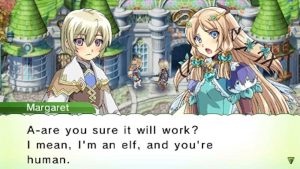
As Lest courts Margaret, she asks him: “A-are you sure it’ll work? I mean, I’m an elf, and you’re a human.” Now, we can answer her: yes, humans and elves can be in a relationship, but only if you, the player, want to make it work. And, in Rune Factory 4, you truly can.[7]
[1] For more information, see “The Psychology of Fandom.”
[2] See “The Neuroscience of Empathy.”
[3] Source: Rune Factory 4’s wiki.
[4] Source: Rune Factory 4’s wiki.
[5] Only heterosexual relationships are possible in the game—not as progressive as it could be, but hey, they are portraying a traditional way of life in a middle-aged town, so I think we can forgive them for that!
[6] Source: Rune Factory 4 wiki, “Dating and Marriage Requirements.”
[7] Thanks to Dai Yang and Dan Hughes for consultation on the substance of this piece.


